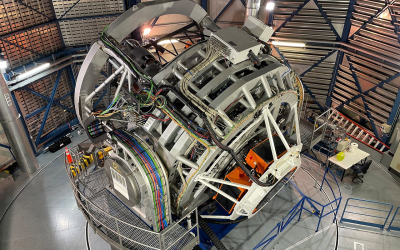EXCLUSIVE: Amplify Pictures is moving its indie TV financing model into the scripted space for the first time. The 100 Foot Wave studio has teamed with Duplass Brothers Productions to make comedic crime-thriller Sleep King.
Both L.A.-based…

EXCLUSIVE: Amplify Pictures is moving its indie TV financing model into the scripted space for the first time. The 100 Foot Wave studio has teamed with Duplass Brothers Productions to make comedic crime-thriller Sleep King.
Both L.A.-based…

Netflix is entering a Black Hole with its latest series project.
The streamer outbid other outlets for a series based on Charles Burns’ Black Hole comics, with I Saw the TV Glow writer-director Jane Schoenbrun set to adapt the story…
This request seems a bit unusual, so we need to confirm that you’re human. Please press and hold the button until it turns completely green. Thank you for your cooperation!

The largest multi-object spectroscopic survey facility in the southern hemisphere, which UCL engineers helped design and build, has taken its first observations, marking the start of its scientific journey. …

In clinical settings, chronic wounds are characterized by a lack of healing or any signs of improvement beyond four weeks.1 A recent systematic review and meta-analysis reported that, worldwide, two to three individuals per 1000…

Security experts have raised significant concerns about the privacy, safety, and data management of new AI-powered browsers, including OpenAI’s newly launched ChatGPT Atlas, following recent research disclosures and new classes of attack…

Olubukola Ayodele/LinkedIn
Olubukola Ayodele, Breast Cancer Lead at University Hospitals of Leicester NHS Trust, shared a post on LinkedIn:

[DAKAR, LONDON, SciDev.Net] Senegal has launched a nationwide, multisectoral response to tackle a growing outbreak of Rift Valley fever (RVF), warning affected communities against risky self-medication.
The coordinated campaign brings together…

Quality analytics has long been seen as key to better understanding benefits utilization and developing strategies that drive up engagement, but getting the analytics hasn’t been easy.
Whether manually crunching data, waiting for partners to provide reports or working with dashboards, extracting and analyzing data can be arduous and time-consuming.
Fortunately, AI agents such as ChatGPT and Len AI, Marsh McLennan’s proprietary AI technology, now allow datasets to be analyzed using natural language so that benefits data can be easily reviewed to uncover valuable insights. Not surprisingly, 50% of employers are already using AI for benefits purposes, and a further 48% plan to use it within the next one to three years. Advanced and predictive analytics, along with personalization, are the main drivers of this trend.[1]
On a practical level, the reduction in administrative burdens is significant. For example, HR teams can see benefits uptake and engagement rates and identify any utilization issues that could be impacting budgets. This frees up time for HR to focus on more strategic initiatives such as understanding how preventative benefits are impacting claims.
Predictive analytics presents a compelling use case for AI, especially in the health and well-being arena. For example, by predicting how many people are likely to fall sick within the year, benefits strategies can be optimized to account for medical inflation and budget considerations in the context of ever challenging resource constrained environment.
This requires building scenarios and simulating the likely outcome of different benefit strategies. For example, if you anticipate a high number of musculoskeletal (MSK) claims, how many are likely to result in longer-term rehabilitation and how might uptake of a preventative benefit change that?
It also requires distinguishing between society-wide issues and those specific to your organization. At Mercer Marsh Benefits (MMB) we can overlay organizational data with huge data sets to help clients identify pockets within their organization that are bucking broader trends.
An even deeper dive can be carried out to identify which clinical pathways, and even healthcare providers, are generating the most successful outcomes. This allows employers to better educate employees on the most effective pathway, hospital, public program or benefit for their needs.
This level of personalization is welcomed by employees, with over two thirds saying they would share their health information with a confidential third party to receive tailored benefits information, or personalized health recommendations.[2]
Of course, no benefit strategy will deliver optimal results if employees are not engaged and aware of their options. AI has a meaningful role to play in increasing utilization by replacing one-size-fits-all communications with compelling content automatically generated and tailored to different employee demographics.
Generative AI chat assistants are now being used by benefits platforms like Darwin with the AI Chat Assistant, to allow employees to get answers to benefits questions such as “Can I add my wife to my dental policy?”. Allowing employees to easily access information and execute tasks not only saves them time and boosts engagement but improves the user experience.
On another level, personalization helps employees discover benefits they didn’t know existed or hadn’t considered. For example, individuals who are looking to exercise more and improve their fitness levels can be signposted towards benefits that can help them achieve these goals, such as gym memberships and wellness programs.
To give employees confidence to share relevant, personal data, it’s important to educate them on the ways data is anonymized or de-identified to protect their privacy. This data is often used to build personas to improve the relevance of what is showcased to employees thereby increasing uptake.
Insights generated by any analytics application are only as good as the data that underlies the analysis. Data integrity is critical as is the governance and processes that sit around it.
Increasing benefits choice used to mean increasing benefits administration, but AI can ingest data more effectively, automate routine tasks, carry out compliance monitoring and reduce human error.
For example, if you had a reimbursement fund to allow people to claim for well-being activities, AI can not only check the receipt to ensure it’s not a duplicate claim, but check the provider actually exists, that the service provided is covered, and that the employee hasn’t gone over their allocation.
Similarly, it can be used to automatically close payroll, enroll new joiners, and run other benefits processes, to significantly reduce administrative overheads. This gives already stretched HR teams more time to focus on more strategic initiatives.
Any AI initiative is only as good as the underlying dataset and building the right AI foundation to centralize and connect that data is critical to success. 88% of employers who centralized their benefits software in this way say they can respond quickly to change, with 73% of those saying they are on track to achieve their employee engagement targets.[3]
AI not only has the potential to improve benefits insights and administration for employees and employers, but it also has the potential to transform the employee experience to create a healthier, more satisfied workforce. As such, half of employers are currently using AI to forecast future benefits needs based on workforce trends, and 58% are personalizing benefit recommendations and communications based on AI insights with a further 33% planning to do so by 2026. This shows a significant move towards employers increasingly leveraging data not only for tracking and forecasting, but also for personalization and improving wellbeing.[4]